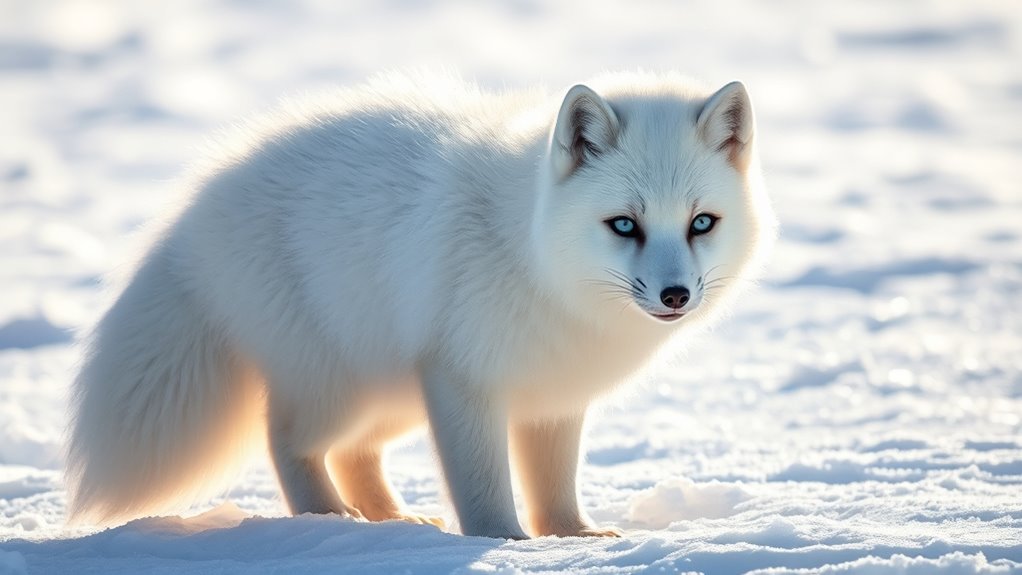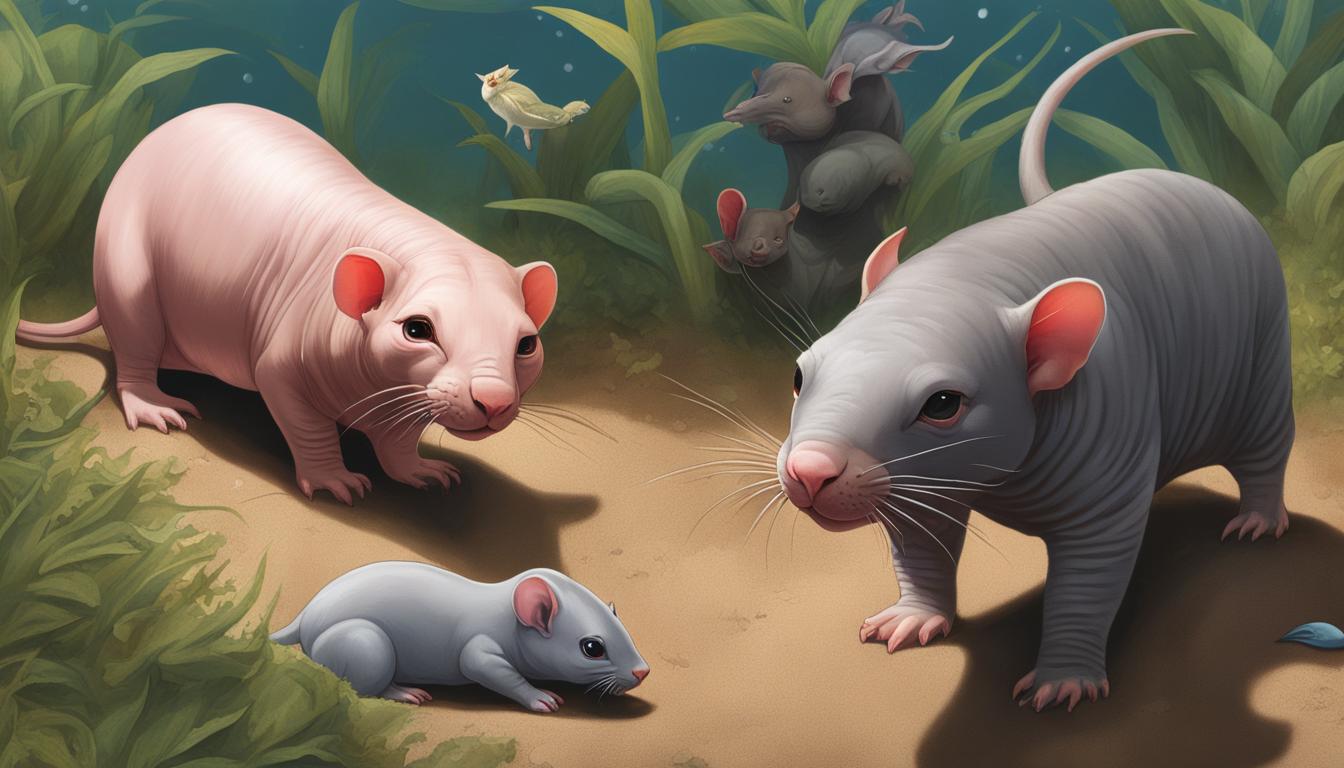The Arctic fox is built for the cold with several unique adaptations. Its thick, dense fur insulates against extreme temperatures and changes color for effective camouflage. Compact body structure minimizes heat loss, while furry foot pads provide insulation and grip on ice. Its keen hearing helps locate prey beneath snow, enhancing its hunting skills. Together, these features guarantee survival in harsh conditions, and there’s more to explore about its fascinating life in the Arctic.
Key Takeaways
- Arctic foxes have thick, dense fur that insulates against extreme cold and changes color for camouflage with the seasons.
- Their furry foot pads provide insulation and grip, enabling safe movement across icy surfaces.
- A compact body structure, with a short muzzle and small ears, minimizes heat loss in frigid temperatures.
- They possess a keen sense of hearing, allowing them to detect prey beneath the snow for effective hunting.
- These adaptations work together, ensuring the Arctic fox thrives in harsh Arctic environments.

Although you might think of the Arctic fox as just another cute, fluffy creature, its adaptations are essential for survival in one of the harshest environments on Earth. Living in temperatures that can plummet to minus 58 degrees Fahrenheit, the Arctic fox has evolved uniquely to thrive in such extreme conditions. One of its most remarkable features is its incredible fur density. This thick, warm coat not only insulates the fox from the biting cold but also changes color with the seasons, providing effective camouflage against the snow in winter and the tundra in summer. The Arctic fox’s fur is a vital lifeline, allowing it to maintain body heat and stay active when many other animals would succumb to the cold.
Another key adaptation involves its foot pads. You might not realize how crucial these pads are, but they significantly enhance the fox’s ability to navigate its icy habitat. The Arctic fox has furry foot pads that provide insulation against the cold ground, keeping its feet warm as it moves across frozen terrain. This adaptation allows the fox to hunt and explore without freezing its extremities. Additionally, the foot pads’ rough texture ensures better grip on slippery surfaces, which is invaluable when chasing prey or avoiding predators.
When you observe the Arctic fox, you’ll notice that its body is compact, which minimizes heat loss. This body structure is another adaptation that helps it survive frigid temperatures. With a short muzzle and small ears, the fox reduces the surface area exposed to the cold while maximizing warmth retention. You can see how each feature plays a role in its survival strategy.
Moreover, the Arctic fox is a clever hunter, using its keen sense of hearing to locate prey beneath the snow. This ability, combined with its thick fur and well-adapted foot pads, makes it a skilled predator in an environment where food can be scarce. You might find it fascinating how these adaptations work together to create a creature perfectly suited for life in the Arctic. Furthermore, the Arctic fox’s survival strategy highlights the importance of biological adaptations in extreme environments.
Frequently Asked Questions
What Do Arctic Foxes Eat During the Winter Months?
During winter months, you’ll find Arctic foxes engaging in winter scavenging, relying on their keen instincts to select prey. They hunt small mammals like lemmings, voles, and even rabbits, but they also scavenge on leftover carcasses from larger predators. Their adaptability in prey selection allows them to survive harsh conditions, ensuring they get enough nutrition to thrive. Even in the cold, these resourceful hunters make the most of their surroundings to find food.
How Do Arctic Foxes Communicate With Each Other?
Arctic foxes communicate with each other using vocal signals and body language. You’ll notice them making a range of sounds, from high-pitched barks to growls, especially during mating season or when defending territory. Their body posture also conveys messages; for example, a fox might crouch low to indicate submission or wag its tail to show excitement. By observing these cues, you can better understand their social interactions and hierarchies.
What Is the Lifespan of an Arctic Fox in the Wild?
In the wild, an arctic fox typically lives around three to six years. However, their lifespan can be longer in protected environments. Their reproductive habits play a role in their survival, as they raise kits in dens, often defending their territory fiercely against intruders. These territorial behaviors guarantee they have enough resources to feed their young, which is vital for the continuation of their species amidst the harsh conditions they face.
Are Arctic Foxes Endangered or Threatened Species?
Arctic foxes aren’t currently classified as endangered, but they face threats that put their conservation status at risk. Habitat loss due to climate change and human encroachment considerably impacts their populations. You should know that while they adapt well to their environment, the changing landscape poses challenges. Supporting conservation efforts can help protect their habitats and guarantee these unique creatures continue to thrive in their natural surroundings.
How Do Arctic Foxes Find Mates in Harsh Conditions?
In the frozen domain where love blooms like a rare flower, arctic foxes find mates through elaborate mating rituals. They engage in playful chases and vocalizations, showcasing their agility and charm. As they navigate harsh conditions, their territorial behavior helps them establish dominance, ensuring they attract the best partners. When the snow settles, you’ll witness these resourceful creatures bond, relying on their instincts and resilience to navigate the challenges of finding love in the wild.
Conclusion
In the frigid embrace of the Arctic, the Arctic fox thrives, showcasing nature’s brilliance in adapting to extreme conditions. With its thick fur and clever hunting strategies, it dances gracefully across the snow, a true master of survival. You can’t help but admire how this small creature turns the harshest environment into its home sweet home. So, next time you think of cold, remember the Arctic fox, a proof of resilience wrapped in a cozy white coat.










